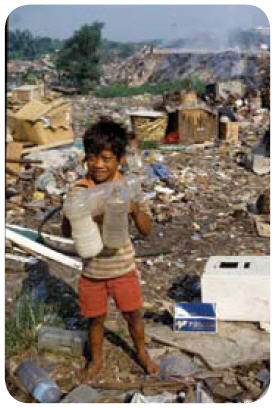It all started when Richard Fuller, President of Blacksmith Institute, walked into my office at NARO one morning in 2002, wanting introductions to ADB staff in Manila.
Blacksmith Institute is a nonprofit organization in New York that helps clean up toxic polluted sites in developing countries. Its focus is legacy sites, where the original polluter is long gone—defunct, bankrupt, or otherwise unavailable to pay for cleanup. In developed countries, government programs—such as SuperFund in the US—have dealt with legacy pollution effectively but the problem has not gained much attention in developing countries. And it has been getting worse as globalization shifts manufacturing—and attendant pollution—to developing countries.
Blacksmith Institute focuses exclusively on sites that poison people. And children tend to be the worst affected. Because of their smaller body weight, exposure to a given dose of toxins has a much greater impact on children than on adults. The most dangerous toxins are lead, mercury, and arsenic (which retard brain development in children); chlorinated solvents (which lead to organ malfunction); radionuclides (which cause cancers); and azodyes and chromium (which affect maternal and infant health). In the worst cases, life expectancy is sharply reduced.
I found Richard’s cause compelling and his passion for protecting children attractive. I therefore took extra trouble to get him appropriate meetings in Manila. I was pleased he had a similar impact on my colleagues at ADB headquarters. He returned to New York with a technical assistance grant of $250,000 from the Poverty and Environment Fund. The purpose was to identify and evaluate a range of polluted sites in India. The output was provided to the Indian government, which promptly requested funds to help clean up the worst sites. As ADB couldn’t offer concessional resources, India is now negotiating a World Bank loan.
I thought my connection with Blacksmith Institute would end there, as I retired from NARO in 2004. Imagine my surprise, then, when Richard called to ask if I would help Blacksmith Institute raise multilateral resources for toxic cleanup! I was delighted: it would give me something worthwhile to do, and make use of my ADB experience. Richard’s and my efforts since then have centered on promoting a health and pollution fund, which we conceive as a multidonor facility that makes grants for cleanup projects. It would be housed partly in ADB (for the Asia and Pacific region) and partly in the World Bank (for the rest of the developing world). We are currently doing the rounds of bilateral aid agencies and are very encouraged by the support expressed thus far.

Child working on a dumpsite.
With funding from the European Commission and Green Cross Switzerland (an NGO), Blacksmith Institute is also implementing the Global Inventory Project to assess toxic sites in over 50 countries. By the end of 2010, about 3,000 sites will have been covered, showing that 200 million people or more are at risk and that this is a health problem of a magnitude similar to malaria and tuberculosis. I’m happy to report that ADB is cofinancing the project with a grant of $900,000. When completed, the project should provide solid evidence to back our case for the health and pollution fund. Watch this space!
